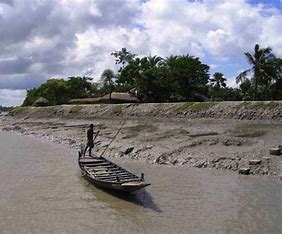The Sundarbans, spanning approximately 10,000 square kilometres across India and Bangladesh, is not only the world’s largest contiguous mangrove forest but also a critical ecological buffer zone and a major economic asset for both countries. Situated at the confluence of the Ganges, Brahmaputra, and Meghna rivers, this unique wetland acts as a natural defence mechanism, particularly against the frequent tropical cyclones that batter the Bay of Bengal. Despite its critical ecological functions, the Sundarbans faces severe challenges, ranging from climate change to unsustainable human activities, putting millions of people and the region’s biodiversity at risk.
Functioning as the “kidneys” of the Earth, wetlands like the Sundarbans play a vital role in regulating water flow and filtering pollutants. Yet, the Sundarbans goes beyond these functions. Its dense mangrove forest diminishes the impact of storm surges and cyclones, providing essential coastal protection. Studies, including one by the World Bank, demonstrate its capacity to reduce surge heights by 4 to 16.5 centimetres, depending on the location. This has proven lifesaving during tropical cyclones like Amphan, Sidr, and Aila, which would have wreaked even greater havoc were it not for this natural barrier.
Beyond environmental resilience, the Sundarbans is an economic powerhouse. Supporting around 7.5 million people, it contributes through provisioning, regulating, and cultural services. Provisioning services — fish, wood, honey, and other resources — have been valued at $713.30 per hectare annually, while its role in air quality improvement, water purification, and storm surge protection contributes $2,584.46 per hectare each year. Cultural services, too, provide intangible benefits, valued at $151.88 per hectare. Such contributions underscore the Sundarbans’ role not only as an ecological asset but as an economic backbone for local communities.
However, climate change and unchecked human activity pose unprecedented threats to this precious ecosystem. Rising sea levels, more frequent cyclones, and increased salinity are pushing the Sundarbans to the brink. With an average elevation of only one meter, even a minor rise in sea level could devastate this region. For instance, a one-meter rise would lead to the complete submergence of the Sundarbans, eliminating its forests and displacing thousands. Records from West Bengal’s Diamond Harbour reveal a sea level rise of 3.95 mm per year since 1972, while in Bangladesh, the rate stands at 0.36 mm annually since 1977. Combined with stronger storm surges, this gradual rise could cripple the mangrove ecosystem, allowing saltwater intrusion and triggering widespread land salinity that jeopardizes drinking water sources, agriculture, and local flora and fauna.
Future climate models paint a stark picture: post-monsoon cyclones in the Bay of Bengal are projected to increase by 50% in frequency by mid-century, with higher intensities. The Sundarbans is also experiencing fewer rainy days but more intense downpours, leading to soil erosion, sedimentation, and shifts in soil chemistry. These changes affect water purification, carbon sequestration, and habitat stability. While rising temperatures could enhance carbon sequestration, the optimal range for mangrove photosynthesis tops out at 38-40°C. With temperatures in the region rising, prolonged droughts and heat spells risk transforming the Sundarbans from a carbon sink into a carbon source, accelerating regional and global warming.
Confronting these threats requires cross-border cooperation. Despite a Memorandum of Understanding signed in 2011 by India and Bangladesh, substantial challenges remain. Discrepancies in environmental policies exacerbate the problem. For example, while India restricts the establishment of thermal power plants within a 25-kilometer radius of the Sundarbans, Bangladesh allows them as close as 10 kilometers. Consequently, the Rampal coal-fired power plant, built just 14 kilometres from the forest, poses a serious threat, as do several cement factories operating within six kilometers. Comprehensive environmental assessments must be enforced before permitting industrial activities in this sensitive area to mitigate such risks.
Additionally, the immense population that depends on the Sundarbans adds to the strain on its resources. Many locals depend on fishing, wood collection, and other extractive activities to survive, often without awareness of the environmental costs. The issue is compounded by illegal wildlife trade and poaching, further endangering biodiversity. Authorities from both nations must enforce stringent regulations to control encroachment and ensure sustainable resource use. Offering alternative livelihoods could also alleviate pressure on the forest, and targeted education campaigns could foster greater environmental stewardship among residents.
The decline of the Sundarbans would be catastrophic for both India and Bangladesh. Losing this natural defence would expose millions to the full brunt of climate change impacts, including intensified cyclones, flooding, and loss of biodiversity. The Sundarbans is not merely a geographical asset; it is an irreplaceable lifeline that underscores the interconnectedness of ecological health and human resilience. Protecting it is not just an environmental obligation but a matter of regional survival.
The future of the Sundarbans rests in a united approach. For the people of both Bengal, the Goddess of the Forest stands as both protector and provider. If we fail to protect her, we risk facing an unspeakable loss that will resonate far beyond the borders of these two nations. It is time for policymakers, citizens, and the international community to come together, prioritize the Sundarbans, and commit to preserving this invaluable ecosystem for generations to come. Saving the Sundarbans is, ultimately, an act of self-preservation.
Tamanna Akter Tithi is associated with Dhaka University, Milan Mathew is associated with IUSS, Pavia and Raktimava Bose is associated with NCAER, Delhi. Views are personal.























